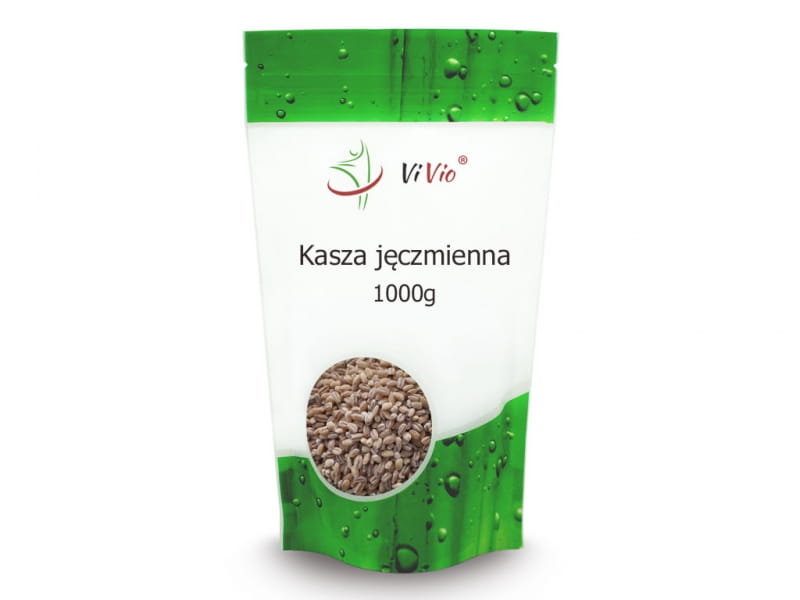Barley groats - pearl barley 1000g - VIVIO
- Regular price
- €4,22
- Regular price
-
- Sale price
- €4,22
- Unit price
- per
Description
xBarley is nothing more than the crushed grain of one of the oldest cereals - barley. It is obtained by cleaning the grains and removing the fruit and seed coat. The next stage of production is polishing, crushing, cutting, grinding and roasting. Barley groats are still underestimated on Polish tables. In Tibet, it is the basis of the local people's diet. In Asian countries, health tea made from naked barley grains is very popular. Glassy grains with a thin shell are used for barley production. Barley groats should be light gray in color with a greenish or yellowish tinge. It has a very distinctive taste and smell. There are different types of barley: pearl barley, rolled pearl barley (Kujawy), broken barley, pearl barley (polished) and roasted pearl barley. Barley groats are the whole grain without the shell. It is the most valuable type of barley.
Cereal products low in barley are a particularly valuable part of our diet, especially because of the high fiber content. Barley groats are such products. It supplies our body with valuable protein. Its content in barley groats is up to 16%. Compared to products made from wheat and corn, barley protein is much more valuable. Barley groats is also an injection of carbohydrates and a source of many vitamins (especially group B). Meals prepared with it will keep you full longer and give you energy for the whole day.
Scientific research shows that the high fiber content in barley groats (especially beta-glucans) helps maintain proper levels of cholesterol in the blood. In addition, barley-based products can also be an important part of the diet of people with diabetes. According to the researchers, barley helps reduce the spike in blood sugar that most commonly occurs after a meal. Scientists also point out that barley products are particularly valuable in the prevention of lifestyle diseases such as overweight, obesity, cardiovascular diseases, colon cancer and pearl barley.
NUTRITIONAL VALUE OF THE PRODUCT IN 100 g
Calorific value - 1546 kJ / 365 kcal
fat - 2.3 g
- including saturated fatty acids - 1.21 g
Carbohydrates - 73.48 g
- including sugar - 0.8 g
Protein - 12.48g
Salt - 0.03 g
NET WEIGHT: 1000 g
INSTRUCTIONS FOR USE
In order to preserve the valuable vitamins and minerals in groats, they should not be cooked in large quantities from water. Maintain the correct proportions so that all of the water can be absorbed by the groats during cooking. To start, it is worth rinsing the groats in the colander under running water. Then boil 3 glasses of water for 1 glass of groats. We add a little salt and a teaspoon of oil. Pour the groats into the boiling water and cook, covered, over low heat for about 20 minutes, until all the water has been absorbed. When the groats are ready, turn off the fire and leave covered for a few minutes.
In Polish cuisine, pearl barley is mainly associated with barley soup. However, it can be used in many other ways. It's an excellent, healthy substitute for potatoes and pasta. It goes well with meat dishes and mushroom sauces. It can be used to prepare cabbage rolls, stuffing for dumplings, casseroles. It is part of the so-called kashotto - a stew that is a tasty and easy idea for a family dinner.
RECOMMENDED STORAGE CONDITIONS
Store cool and dry.
similar products
- Regular price
- €4,22
- Regular price
-
- Sale price
- €4,22
- Unit price
- per
- Regular price
- €4,22
- Regular price
-
- Sale price
- €4,22
- Unit price
- per
- Regular price
- €4,22
- Regular price
-
- Sale price
- €4,22
- Unit price
- per
- Regular price
- €4,22
- Regular price
-
- Sale price
- €4,22
- Unit price
- per
- Regular price
- €4,22
- Regular price
-
- Sale price
- €4,22
- Unit price
- per
- Regular price
- €4,22
- Regular price
-
- Sale price
- €4,22
- Unit price
- per
- Regular price
- €4,22
- Regular price
-
- Sale price
- €4,22
- Unit price
- per
- Regular price
- €4,22
- Regular price
-
- Sale price
- €4,22
- Unit price
- per
- Regular price
- €4,22
- Regular price
-
- Sale price
- €4,22
- Unit price
- per
- Regular price
- €4,22
- Regular price
-
- Sale price
- €4,22
- Unit price
- per
Recently Viewed Products
- Choosing a selection results in a full page refresh.











